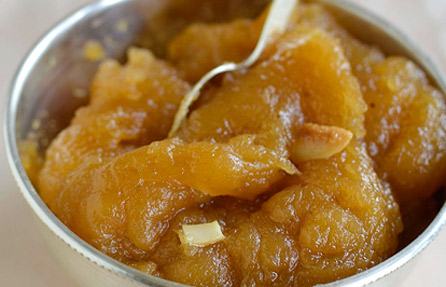5 Must-Try Indian Halwa Recipes

Perhaps the reason Indian cuisine boasts such a wide variety of fans all over the world is that the sheer variety means you can find a list of delicious dishes suitable for almost any taste. If spicy sauces tempt your tastebuds, enter the world of full-flavoured curries, layered with hot chillies. If light, fresh dishes hold more of an appeal, the menu of South India offers seafood specialities and delicious, coconut-infused vegetarian options. And if you worship at the altar of all things sweet, Indian desserts provide a sugar high, guaranteed to hit the spot.
Some Indian desserts may be more familiar than others to our Western palates. Barfi, for example, has the creamy, melt-in-the-mouth texture of buttery soft fudge; kulfi holds all the frozen appeal of ice-cream, with a dense luxuriance due to its lack of aeration; and kheer is a warm bowl of comforting porridge, sweetened with dried fruit and nuts.
However, one of the most popular dessert options in India is one that might seem somewhat unusual to us here in the UK. Halwa is consumed throughout the sub-continent, recipes varying from region to region due to the availability of ingredients offering different flavours. It is a dense, sugary type of sweet that is prepared with care and consumed at traditional weddings and festivals as well as making an excellent everyday treat.
Here are some of our favourite versions of Indian halwa–but be warned, halwa can be addictive…
One of the most popular desserts in India, gajarkahalwa is a Punjabi creation that is greatly enjoyed in the winter months. Grated carrots, milk, nuts and sugar are cooked in ghee and flavoured with cardamom, chopped fruit and nuts.
Created from grated bottle gourd, also known in India as ‘dhoodi’, this recipe involves sweetened milk and plenty of sugar to achieve a deliciously sinful tasting sweet that surely still counts as one of your five a day…That’s how it works, right?
Another Indian classic, this dish calls for semolina – not an ingredient you are likely to find in your store-cupboard here in the UK, but one that experiences a lot of use in the kitchens of India. The semolina is cooked until brown and then mixed with coconut, raisins, cashew nuts and almonds to form a thick and satisfyingly stodgy halwa.
A slightly different take on the halwa recipe, this traditional sweet is created by boiling milk, water, sugar and cornflour until it solidifies. This makes it unusual compared to the other softer halwas of India.
The famous black halwa of Kerala, karuthahalwa is made using rice, jaggery, flour and lashings of coconut milk. The end result is a thick, sticky, dark sweet with a rather unusual colouration.
The unusual halwas of India are certainly worth a try for any dessert aficionado.Pay a visit to one of London’s best Indian fine dining restaurants for a range of equally decadent and creative desserts, all based, of course, on traditional Indian flavours and recipes.
